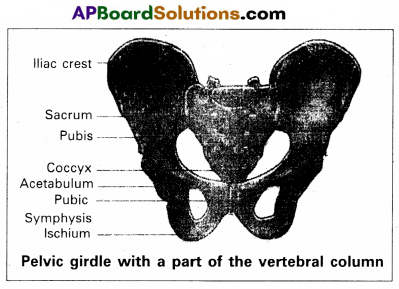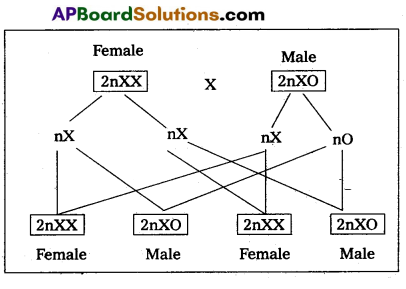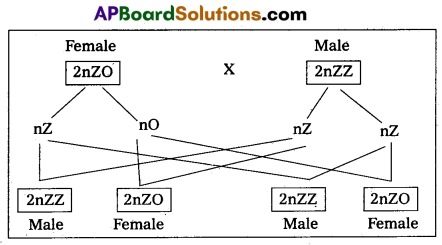Thoroughly analyzing TS Inter 2nd Year Zoology Model Papers and TS Inter 2nd Year Zoology Question Paper March 2019 helps students identify their strengths and weaknesses.
TS Inter 2nd Year Zoology Question Paper March 2019
Time: 3 Hours
Maximum Marks: 60
Instructions:
Note : Read the following instructions carefully.
- Answer all questions of Section ‘A’. Answer ANY SIX questions in Section ‘B’ and answer ANY TWO questions in Section ‘C’.
- In Section ‘A’, questions from Sr Nos. 1 to 10 are of ‘Very Short Answer Type’. Each question carries TWO marks. Every answer may be limited to 5 lines. Answer all these questions at the one place in the same order.
- In Section ‘B’, questions from Sr. Nos. 11 to 18 are of ‘Short Answer Type’. Each question carries FOUR marks. Every answer may be limited to 20 lines.
- In Section ‘C’, questions from Sr. Nos. 19 to 21 are of ‘Long Answer Type’. Each question carries EIGHT marks. Every answer may be limited to 60 lines.
- Draw labelled diagrams, wherever necessary in Sections ‘B’ and ‘C’.
Section – A (10 × 2 = 20)
Note : Answer all the questions in 5 lines each:
Question 1.
What is Chyme ?
Answer:
Semi fluid mass of partly digested acidic food formed in the stomach is called chyme.
Question 2.
What are the Columns of Bertin ?
Answer:
Columns of Bertin are the medullary extensions of the renal cortex in between the renal pyramids.
![]()
Question 3.
Name the keystone bone of the cranium. Where is it located ?
Answer:
Sphenoid bone is the keystone bone of the cranium, because it articulates with all the other cranial bones. It is present at the middle part of the base of the skull.
Question 4.
How do Rods and Cones of human eye differ from each other chemically and functionally ?
Answer:
Rods : Rods contain a purplish red protein called rhodopsin, which contains a derivative of vitamin A. Rods are concerned with dim light.
Cones : Cones contain a visual pigment called iodopsin, made of a protein called photopsin and they are important in daylight vision and colour vision.
Question 5.
What are the measures one has to take to prevent contracting STDS ?
Answer:
The measures one has to be taken to prevent STDs are :
a) Avoiding sex with unknown partners / multiple partners.
b) Using condoms compulsorily during coitus.
c) Consulting qualified doctor for early detection of STDs and getting complete treatment in case of infections.
Question 6.
What is “Capacitation” of sperms ?
Answer:
Capacitation of sperm refers to the physiological changes that the spermatozoa undergoes to be able to penetrate and fertilize an egg.
Question 7.
What are multiple alleles ?
Answer:
If a gene has more than two alleles then they are said to be multiple alleles. Eg : In humans ABO blood groups are the best example for multiple allelism.
Question 8.
Distinguish between a Drone and Worker in a honey-bee colony.
Answer:
| Drones | Worker bees |
| 1) These are fertile males. | 1) These are sterile female. |
| 2) These are developed from unfertilized ova by male parthenogenesis. | 2) These are developed from fertilized eggs. |
| 3) These are short lived. | 3) These live for two and three months. |
Question 9.
What is Turner’s syndrome ?
Answer:
It is an allosomal disorder. The Karyotype is 45, it is due to monosomy in 23rd pair. These females have 42 autosomes and one X-chromosome.
Symptoms : Short structure, gonadal dysgenesis, webbed neck, broad shield like chest and widely spaced nipples etc. Turners female does hot show barr bodies.
![]()
Question 10.
Mention any four fish by – products.
Answer:
- Shark and cod liver oils
- Fish guano
- Shagreen
- Isinglass.
Section – B (6 × 4 = 24)
Note : Answer any six questions in 20 lines each:
Question 11.
Describe the process of digestion of proteins in the stomach.
Answer:
Protein digestion begins in the stomach. The food entered into the stomach is mixed thoroughly with the gastric juice of the stomach by the churning movements of its muscular wall and the product is called chyme. The main components of gastric juice are protein digestive enzymes, hydrochloric acid and mucus.
HCl provides the acidic pH (1.8) which is optimal for the action of pepsin. The proenzymes of gastric juice, the pepsinogen and prorennin, on exposure to hydrochloric acid are converted into the active enzymes, pepsin and rennin respectively. Pepsin converts proteins into proteoses and peptones. Rennin is a proteolytic enzyme found in the gastric juice of infants. It acts on the milk protein, the casein in the presence of calcium ions and converts it into calcium paracaseinate and proteoses. Pepsin acts on calcium paracaseinate’ and converts it into peptones. The entire process of protein digestion in the stomach takes about 4 hours.

Question 12.
Describe disorders of Respiratory system.
Answer:
Disorders of respiratory system :
1) Asthma : Asthma is a difficulty in breathing caused due to inflammation of bronchi and bronchioles. Symptom^ include coughing, difficulty in breathing and wheezing.
2) Emphysema: It is a chronic disorder in which alveolar walls are damaged and their walls coalesce due to which respiratory surface area of exchange of gases is decreased. One of the major causes of this is smoking of tobacco.
3) Bronchitis : Bronchitis is the inflammation of the bronchi, resulting in the swelling of mucus lining of bronchi, increased mucus production and decrease in the diameter of bronchi. Symptoms include chronic cough with thick sputum.
4) Pneumonia: The infection of lungs caused by Streptococcus pneurponiae and also by certain Virus, Fungi, Protozoans and Myco- plasmas. Symptoms include inflammation of lungs, accumulation of mucus in alveoli and impaired exchange of gases, leading to death if untreated.
Occupational dissorders : These are caused by exposure of the body to the harmful substances.
E.g. :
i) Asbestosis : It occurs due to chronic exposure to asbestos dust in the people working in asbestos industry.
ii) Silicosis : It occurs because of long term exposure to silica dust.
iii) Siderosis : It occurs due to deposition of iron particles in tissues.
iv) Black lung disease : It develops from inhalation of coal dust.
Question 13.
Draw a neat labelled diagram of pelvic girdle.
Answer:

Question 14.
Write a note on Addison’s disease and Cushings syndrome.
Answer:
Addison’s disease : It is caused due to hyposecretion of glucocorticoids by the adrenal cortex. This disease is characterised by loss of weight, muscle weakness, fatigue and reduced blood pressure. Sometimes darkening of the skin in both exposed and non- exposed parts of the body occurs in this disorder.
Cushing’s Syndrome : It results due to over production of glucocorticoids. This condition is characterised by breakdown of muscle proteins and redistribution of body fat resulting in spindly arms and legs, a round moon-face, buffalo hump on the back and pendulous abdomen is also observed. Wound healing is poor. The elevated level of cortisols causes hyperglycemia, over deposition of glycogen in liver and rapid gain of weight.
Question 15.
Explain the mechanism by which HIV multiplies and leads to AIDS.
Answer:
AIDS is non-congential, transmissible, lethal, sexually transmitted disease caused by Human Immuno deficiency Virus (HIV). HIV is a retro virus with an envelop enclosing two ss RNA molecules as the genetic material.
Mechanism : After getting into the body of a person, the HIV enters the TH cells, macrophages or dendritic cells. In these cells ss RNA of HIV synthesizes a DNA strarid complementary to the viral RNA using the enzyme reverse transcriptase. The same enzyme responsible for formation of second DNA strand, complementary to the first strand forming the double stranded viral DNA. This dsDNA gets incorporated into the DNA of the host’s DNA by a viral enzyme called integrase and it is in the form of a provirus.
Transcription of DNA results in the production of RNA, which can act as the genome for new virus and it can be translated into viral proteins. The various components of the viral particles are assembled and the HIV particles are produced. The infected human cells continue to produce virus particles. New viruses bud off from the host cell and attack another TH cells. This leads to decrease CD4 receptors containing TH cells in the infected person leading to the immuno deficiency in him, finally causes AIDS.
![]()
Question 16.
Discuss the role of different patterns of selections in evolution.
Answer:
Natural selection is a process by which the organisms are physically, physiologically and behaviourally better adopted to environment, survive and reproduce.
It is mainly of three types :
1. Stabilizing selection,
2. Directional selection,
3. Disruptive Selection.
1. Stabilizing selection (Centrifetal selection): This selection operates in a stable environment. In this process, the organisms with average “phenotype are preserved where as the extreme individuals from both the ends are eliminated, Hence it does not promote any evolutionary change that leads to specification, but maintains the phenotypic stability within the population over generations.
Eg : In England weight of newborn babies were studied in a large sample. Greater mortality was found in the babies whose weight was greater or lesser than the average weight of 81bs.
2. Directional selection : This selection operates in an environment which gradually undergoes changes. It works by constantly removing the individuals from one end and constantly shifting the average value of fitness towards the other end of phenotypic distribution.
Eg : In case of giraffes the average value of the length of neck shifted towards the long-neck. Stabilizing selection takes over the directional selection. Once the average value of the phenotype coincides with the new optimum environmental conditions.
3. Disruptive selection (Centrifugal selection) : This selection operates when homogenous environment changes into a hetefogerious type, fn this process, the organism of both the extreme phenotypes are selected while the individuals with average phenotype are eliminated. This can split the population into two or more sub-populations or species populations.
Eg : In California the sunflower population was divided into two sub – populations. One was adapted to dry area and the other was adapted to wet area.
Question 17.
Explain Darwin’s theory of Natural Selection with industrial melanism as an experimental proof.
Answer:
Darwin’s theory of natural selection does not explain what exactly evolution is, but explains how evolution might have occurred in nature. A classical example for natural selection is industrial melanism, exhibited by peppered moth-Biston betularia. These moths were available in two colours grey apd black. Grey moths were abundant before industrial revolution in all over England. The reason for the existence of large number of grey moths during that period was camouflage on the trunks of trees. But after the establishment of industries in England, black coloured moths were more and grey forms were less. This is due to pollution from industries in the form of soot turned barks of trees into black. So grey moths were easily identified and were more predated by birds. Thus grey moths decreased in number, black moths increased in the population.
Thus natural selection favoured the melanic moths (black) to reproduce more successfully. Natural selection of darker forms in response to industrial pollution is known as industrial melanism.
Question 18.
Write about the procedure involved in MRI.
Answer:
MRI Scan is a diagnostic radiology technique that uses magnetism, radiowaves and a computer to produce images of body components.
Procedure : MRI Scanner is giant circular magnetic tube.
- The patient is placed on a movable bed that is inserted into the magnet.
- Human body is mainly composed of water which contains two protons.
- The magnet creates a strong magnetic field that makes these proton align with the direction of the magnetic field.
- A second radiofrequency electromagnetic field is then turned on for a brief period. The protons absorb some energy from these radio waves.
- When this second radio frequency emitting field is turned off, the protons release energy at a radiofrequency which can be detected by the MRI scanner.
- Different types of tissues emit different quanta of energy. Abnormal tissues such as tumors can be detected because the protons in different types of tissues return to their equilibrium state at different rates.
- Tissues of bone with less water content look different in MRI, and pathological tissues also can be detected.
The information received is processed by computer and generated an image.
![]()
Section – C (2 × 8 = 16)
Note : Answer any two questions in 60 lines each:
Question 19.
Describe the Excretory system of man, giving the structure of a Nephron.
Answer:
In humans, the excretory system consists of a pair of kidney, a pair of ureters, a,urinary bladder and urethra.
Kidney : Kidneys are reddish brown, bean shaped structures, situated on either side of the vertebral column between the levels of last thoracic and third lumbar vertebrae in a retroperitoneal position. The right kidney is slightly lower than the left one due to the presence of liver.
The outer surface of the kidney is convex and the inner surface is concave, where it has a deep notch called hilum, the point at which the renal artery and nerves enter and renal vein and ureter leave. Each kidney is surrounded by a tough, fibrous tissue, called renal capsule.
Ureter : These are slender whitish tubes, which emerges from the pelvis of the kidney The ureter rundown and open into the urinary bladder.

Urinary bladder : Urinary bladder is a pear shaped like muscular organ. It tempararily stores the urine, situated in the lower abdominal cavity. The neck of the bladder leads into the urethra. Urethra opens near the vaginal orifice in the female and through the penis in the male.
Structure of nephron : Each kidney has nearly one million nephrons. These are structural and functional units of kidney, embedded in the loose connective tissue of cortex and medulla. Nephron consist of malpighian body and renal tubule.
I) Malphigian body : It begins in the cortex of the kidney. It contains Bowman’s capsule and glomerulus.
a) Bowman’s capsule : It is a thin walled, double layered cup. The inner wall of the Bowman’s capsule has certain unique cells called podocytes.
b) Glomerulus : It is a dense network of capillaries in the cup of Bowman’s capsule. Afferent arteriole of renal artery enter the cavity of Bowman’s capsule and split into five branches. They unite and come out of the Bowman’s capsule as an afferent arteriole.
The podocytes of inner wall of Bowman’s capsule wrap around each capillary. The podocytes are arranged in an intricate manner so as to leave some minute spaces called Alteration slits. The endothelium cells of capillaries have numerous pores called fenestrations.

II) Renal tubule : It is narrow, delicate tubule arises from the posterior part of Bowman’s capsule known as neck. It opens into along narrow convoluted tubule with three parts like proximal convoluted tubule, Loop of Henle and Distal convoluted tubule.
a) Proximal convoluted tubule : It is a lined by simple cuboidal epithelium with brush border to increase area of absorption.
b) Loop of Henle: It is a hairpin like tubule present in medulla region. It consist of a descending limb and an ascending limb. The proximal part of the ascending limb is thin and the distal part is thick. The thick ascending limb continuous into the distal convoluted tubule.
c) Distal convoluted tubule (DCT) : It is present in cortex. It is lined by simple cuboidal epithelium. The DCT continuous as the initial collecting duct in the cortex.
Collecting system : Some initial collecting ducts unite to form straight collecting duct, which passes through the medullary pyramid. In the medulla, the tubes of each pyramid join and form duct of Bellini, which finally opens into tip of the renal papilla.
Capillary network of nephron : The efferent arteriole emerging from the glomerulus forms a fine capillary network called the peritubular capillaries, around the renal tubule. The portion of the peritubular capillaries that surrounds the loop of Henle is called the vasa recta. The vasa recta is absent or highly reduced in the cortical nephrons. The juxta medullary nephrons possess well developed vasa recta.
Question 20.
Describe female reproductive system of woman with the help of a labelled diagram.
Answer:
The female reproductive system consists of a pair of ovaries along with a pair of oviducts, uterus, vagina and the external genetalia located in the pelvic region. These parts of the system along with a pair of mammary glands are integrated structurally and functionally to support the processes of ovulation, fertilization, pregnancy, birth and child care.

1) Ovaries : Ovaries are the primary female sex organs that produce the female gametes (ova) and several steroid hormones (ovarian hormones). A pair of ovaries is located on each side of lower abdomen. The double layered fold of peritoneum connecting the ovary with the wall of abdominal cavity is known as the meso-ovarium.
The Ovaries are covered by a layer of germinal (ovarian) epithelium. Underneath this layer, there is a dense connective tissue capsule called, ‘tunica albuginea’. The ovarian stroma is distinctly divided into an outer cortex and an inner medulla. The cortex appears more dense and granular due to numerous ovarian follicles. The medulla is a loose connective tissue with abundant blood vessels, lymphatic vessels and nerve fibres.
2) Fallopian tubes (oviducts) : Each fallopian tube extends from the periphery of each ovary to the uterus and it bears a funnel shaped infundibulum, with finger like projections called ‘fimbriae’, which help in collection of ovum after ‘ovulation’.
The infundibulum leads to a wider part of the oviduct called ‘ampulla’. The last part of the oviduct, ‘isthmus’ has a narrow lumen and it joins the uterus. Fallopian tube is the site of fertilization. It conducts the ovum or zygote towards the uterus by peristalsis. The fallopian tube is attached to the abdominal wall by a peritoneal fold called ‘meso salpinx’.
3) Uterus : The uterus is a single and it is also called womb. It is a large, muscular, highly vascular and inverted pearshaped structure present in the pelvis between the bladder and rectum. The lower narrow part through which the uterus opens into the vagina is called ‘cervix’. The cavity of the cervix is called ‘cervical canal’ which along with the vagina forms the ‘birth canal’.
The wall of the uterus has three layers of tissue. The external thin membranous ‘perimetrium’, the middle thick layer of ‘myonietrium’ and inner glandulas lining layer called ‘endometrium’. The endometrium undergoes cyclic changes during menstrual cycle while myometrium exhibits strong contractions during parturition.
4) Vagina : The vagina is a large, median, fibromuscular tube that extends from the cervix to the vestibule (the space between labia minora). It is lined by non-keratinised stratified squamous epithelium. It is highly vascular and opens into the vestibule by the vaginal orifice.
5) Vulva : Vulva or pudendum refers to the external genitals of the female. The vestibule has two apertures – the upper ‘ external urethral orifice of the urethra and the lower vaginal orifice of vagina. Vaginal orifice is covered by a mucous membrane ‘hymen1, vestibule is bound by two pairs of fleshly folds of tissue called inner ‘labia minora’ and outer larger ‘labia majora’. Clitoris is a sensitive, erectile structure, that lies at the upper junction of the two labia minora above the urethral opening. There is a cushion of fatty tissue covered by skin and pubic hair present above the labia major, called mons pubis. ’
Accessory reproductive glands of female : These include;
a) Bartholin’s glands : These are two glands located slightly posterior and to the left and right of the opening of the vagina. They secrete mucus to lubricate the vagina and are homologous to the bulbourethral glands of the male reproductive system.
b) Skene’s glands : These are located on the anterior wall of vagina, around the lower end of the urethra. They secrete a lubricating fluid when stimulated. The skene’s glands are homologous to the prostate gland of the male reproductive system.
c) Mammary glands : These are paired structures tha. ~ortair glandular tissue and fat. The alveoli cells present on the mammary lobes of each glandular tissue secrete milk which is stored in cavities of alveoli. The alveoli open into im unary tubes and then to mammary ducts, from there to mai mary ampulla and finally connected to lactiferous duct i i’ough which milk is sucked out by the baby.
![]()
Question 21.
Describe chromosomal theory of sex determination.
Answer:
Chromosomal sex determination : The chromosomes, which determine the somatic characters of an individual are known as autosomes. These chromosomes do not differ in morphology and number in male and female sex. Those chromosomes, which differ in morphology and number in male and female sex and contain genes responsible for the determination of sex are known as allosomes or sex chromosomes. There are two types of sex chromosomal mechanisms :
a) Heterogametic male and
b) Heterogametic female.
a) Heterogametic male : In this mechanism, the female sex has two ‘X’ chromosomes, while the male sex has only a single X chromosome.
The heterogametic male may be of the following two types :
(i) XX – XO
(ii) XX – XY
i) XX – XO type : In certain insects belonging to orders Hemiptera (true bugs), Orthoptera (grass hoppers) and Dictyoptera (cockroaches) female has two ‘X” chromosomes (XX) and are, thus homogametic, while male has only single ‘X” chromosome (XO). The male being heterogametic sex- produces two types of sperms, half with X chromosome and half without X chromosome in equal proportions. The sex of the offspring depends upon the sperm that fertilises the egg, each of which carries a single X chromosome. Thus fertilisation between male and female gametes always produced zygotes with one X chromosome from the female, but only 50% of the zyg ites have an additional X Chromosome from the male. In this way ‘X’)’ and XX’ types would be formed in equal proportions, the former being males and the latter being females.

ii) XX – XY type : In man, other mammals, certain insects including Drosphila, the females possess two X chromosomes (XX) and are thus homogametic, produce one kind of eggs, each one with one X chromosome.’While the males possess one X and one Y chromosome (XY) and are hence, heterogametic. They produce two kinds of sperms, half with X chromosome and half with Y chromosome. The sex of embryo depends on the kind of sperm. An egg fertilised hy a X bearing sperm, produces a female, but if fertilised by a Y bearing sperm, a male is produced.

b) Heterogametic female: In this method of sex determination, the male produces similar type of gametes, while female produce dissimilar gametes. The heterogametic females may be of following two types,
(i) ZO – ZZ
(ii) ZW – ZZ.
i) ZO – ZZ : This mechanism is found in certain moths and butterflies. In this case, female possesses one single ‘Z’ chromosome and hence is heterogametic, producing two kinds of eggs half with Z chromosome and another half without any Z chromosome. Male possesses two Z chromosomes and thus homogametic, producing single type of sperms, each carries single Z chromosome. The sex of the offspring depends on the kind of egg.

ii) ZW – ZZ : This system is found in certain insects (gypsy moth) and vertebrates such as fishes, reptiles and birds. In this system, the female is heterogametic and produces two types of gametes, one with ‘Z’ chromosome and the other with ‘W’ chromosome. On the other hand, male is homogametic and produces all sperms of same type carrying one ‘Z’ chromosome. The sex of the offspring depends on the kind of egg being fertilised. The ‘Z’ chromosome bearing eggs produce males, but the ‘W’ chromosome bearing eggs produces females.
